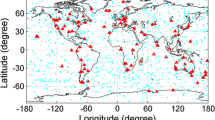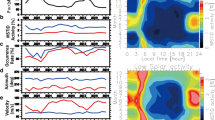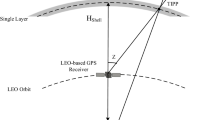Abstract
With worldwide increased Global Navigation Satellite System (GNSS) receivers, it is possible to obtain the ionospheric total electron content (TEC) and hence monitor the ionosphere with GNSS. Using a thin layer assumption of the ionosphere and dual-frequency Global Positioning System (GPS) observations from 16 geomagnetically quiet days in four seasons of 2006, this paper adopts the spherical harmonic model to fit TEC and investigates the effects of two network constitutions on global TEC derivation, one with 275 GPS receivers and the other with 125 GPS receivers. The results show that the data can be well fitted for both network constitutions. The derived TECs are consistent with each other for four seasons. This is especially true for TECs at low- and mid-latitude. The derived satellite and receiver biases are stable during the year. The standard deviation of the satellite and the receiver biases are less than 0.5 and 3 ns, respectively.
Access this chapter
Tax calculation will be finalised at checkout
Purchases are for personal use only
Similar content being viewed by others
References
Lanyi GE, Roth T (1988) A comparison of mapped and measured total ionospheric electron content using global positioning system and beacon satellite observations. Radio Sci 23(4):483–492
Coco DS, Coker C, Dahlke SR, Clynch JR (1991) Variability of GPS satellite differential group delay biases. IEEE Trans Aerosp Electron Sys 27(6):931–938
Sardon E, Rius A, Zarraoa N (1994) Estimation of the transmitter and receiver differential biases and the ionospheric total electron content from global positioning system observations. Radio Sci 29(3):577–586
Mannucci A, Wilson B, Yuan D, Ho C, Lindqwister U, Runge T (1998) A global mapping technique for GPS-derived ionospheric total electron content measurements. Radio Sci 33(3):565–582
Iijima B, Harris I, Ho C, Lindqwister U, Mannucci A, Pi X, Reyes M, Sparks L, Wilson B (1999) Automated daily process for global ionospheric total electron content maps and satellite ocean altimeter ionospheric calibration based on global positioning system data. J Atmos Sol Terr Phys 61(16):1205–1218
Rideout W, Coster A (2006) Automated GPS processing for global total electron content data. GPS Solut 10(3):219–228
Ma G, Maruyama T (2003) Derivation of TEC and estimation of instrumental biases from GEONET in Japan. Ann Geophys 21:2083–2093
Li Z, Yuan Y, Li H, Ou J, Huo X (2012) Two-step method for the determination of the differential code biases of COMPASS satellites. J Geod. doi:10.1007/s00190-012-0565-4
Gao W, Ma G, Chen Y, Shen H, Li J, Huang W, Li Z (2008) Derivation of GPS-TEC and instrumentao biases in the equatorial anomaly region. Chin J Space Sci 28(6):541–546
Ma G, Gao W, Li J, Chen Y, Shen H (2014) Estimation of GPS instrumental biases from small scale network. Adv Space Res 54:871–882
Kaplan ED, Hegarty CJ (2006) Understanding GPS: principles and applications. Artech House Publishers, London
Liu J, Chen J, Zhang Y, Li S, Ge M (1999) WADGPS principle and method. Surveying and mapping Press, Wuhan
http://gpspp.sakura.ne.jp/, Cited 20 Mar 2015
Zhang X (2004) Matrix analysis and applications. Tsinghua University Press, Beijing
Acknowledgments
This work is supported by the National Natural Science Foundation of China (Grant Nos. 11473045, 11403045).
Author information
Authors and Affiliations
Corresponding author
Editor information
Editors and Affiliations
Rights and permissions
Copyright information
© 2016 Springer Science+Business Media Singapore
About this paper
Cite this paper
Wang, X., Ma, G., Wan, Q., Li, J., Fan, J., Zhang, J. (2016). The Effect of GNSS Sites Distribution on TEC Derivation. In: Sun, J., Liu, J., Fan, S., Wang, F. (eds) China Satellite Navigation Conference (CSNC) 2016 Proceedings: Volume I. Lecture Notes in Electrical Engineering, vol 388. Springer, Singapore. https://doi.org/10.1007/978-981-10-0934-1_3
Download citation
DOI: https://doi.org/10.1007/978-981-10-0934-1_3
Published:
Publisher Name: Springer, Singapore
Print ISBN: 978-981-10-0933-4
Online ISBN: 978-981-10-0934-1
eBook Packages: EngineeringEngineering (R0)




